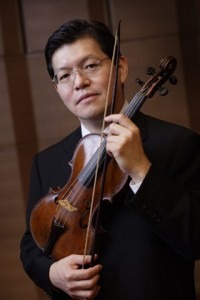 A masterclass of The Hong Kong Arts Festival PLUS. 22 Feb 2011, Concert Hall, HKAPA.
A masterclass of The Hong Kong Arts Festival PLUS. 22 Feb 2011, Concert Hall, HKAPA.
Whether you are an instrumentalist or just a mere enthusiast without instrumental training, the Art Festival Plus Masterclass series is definitely worth your investment of time. Not only can you be rewarded with ample inspiration as the performer dissects and shares certain techniques and musical vocabularies, but also get a closer observation on his story of success.
A ‘minimalist’ speaker he may seem, every piece of advice Mr Terakado gives is sharp and enlightening: his notices that violin players tend to look for horizontal melodies instead of vertical harmony when playing Baroque music, which sometimes inhibits the flow of expressivity. In view of this, he systematically dissects the structure of Baroque pieces with emphasis on the importance of bass line. Form, use of bowing, phrasing, rhythm, balance, all of which are of equal and irreplaceable significance to Mr Terakado’s music-making.
In my eyes, Mr Terakado’s success can be associated with his tireless pursuit of refinement and balance. His prompt diagnosis of each student’s major weakness comes with a clear guidance and demonstration phrase by phrase. His patience is never defeated by unsuccessful comprehension and imitation of his advices-rather, he’d explain in more detail, demonstrate once again and invite students to make further attempts. It is such persistence and attention to details that shapes the violinist before us who sets a high standard to every single note to be glided along with his bow strokes. And even more valuable is Mr Terakado’s generosity in sharing his recipe of success with young musical talents in Hong Kong by being a sincere mentor. I really look forward to his performance (as well as his masterclass, if possible) in Hong Kong again this September!
Photo credit: ryoterakado.com
More Guest Posts
-
 The Summer Soundtrack: How Classical Music Shapes Childhood Memory and Emotional Growth Discover how classical music help develop children's brains during vacation
The Summer Soundtrack: How Classical Music Shapes Childhood Memory and Emotional Growth Discover how classical music help develop children's brains during vacation -
 Ray Chen’s Player 1: A New Paradigm in Classical Performance Practice or Commercial Experiment? Explore his new album 'Player 1,' which juxtaposes video game music with Korngold's works
Ray Chen’s Player 1: A New Paradigm in Classical Performance Practice or Commercial Experiment? Explore his new album 'Player 1,' which juxtaposes video game music with Korngold's works -
 Narration is the Key to Connecting with Audiences Pianist Nikita Lukinov reveals how his narration brings 'Pictures at an Exhibition' to life
Narration is the Key to Connecting with Audiences Pianist Nikita Lukinov reveals how his narration brings 'Pictures at an Exhibition' to life -
 Can Classical Music Help You Study? Not all classical music is created equal for studying!
Can Classical Music Help You Study? Not all classical music is created equal for studying!




